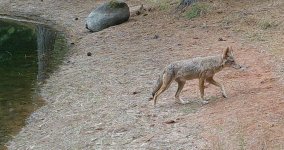k0ua
Epic Contributor
Yes they can. Just like any other dog. But it's illegal for vets to treat them or give them rabies shots. And if a coyote does get a rabies shot, it can't be proved, like with a dog tag or papers filed with the county, etc. So if Sandy, for instance, was to scratch or bite someone while living with us, she would be killed and disected to look for rabies. That was the biggest danger to keeping her. One complaint to Animal Control and she would be killed.
Coyotes are legally just considered "wildlife", meaning they are on their own and should be left alone. They can be helped if abandoned or injured, but only by a licensed wildlife center such as Southwest Wildlife.
Sandy is a special case because she was found abandoned and nearly dead at only a day or two old. Liye saved her and or dog Beibei helped raise her. She is naturally very friendly and not aggressive. It's an unusual case and she could not be returned to the wild because she was unprepared to hunt and only mildly cautious around people. If she was out in the forest somewhere and came up to a passer-by for help, she would likely be shot either for fun or because she would be misunderstood.
Most folks, it seems, either think coyotes are good for target practice or should all be exterminated.
Her story helps demonstrate that there is a lot more to them than we may realize. However, it is a bad idea to try to domesticate one, as not all of them are friendly, their behaviour is directly related to when they were taken from the litter, it's illegal and you are not likely to get medical help if needed for them. And, of course, the rabies shot problem I already mentioned.
Sandy is nearly the same as a domestic dog. Friendly, fun, intuitive, extremely smart and dedicated to her pack mates. She is aware of the hierarchy of the family, or pack structure. She understands hunting strategy. She carries coyote traits like being cautious and looking for the intention in people she meets. She invents keep-away games, has a sense of humor and is very curious. She is an excellent companion and wants to be included, while having a cat-like independence. She makes various sounds, but doesn't really bark. She expresses herself in dog-like ways that people and other dogs understand, so she can meet and interact with other dogs and people. She has no idea how vulnerable she is and lives life to the fullest, in the moment, with joy. If she didn't look like a coyote, she could likely fit in as a family dog and be fine for life. But her appearance gives her away first and leads to all the other problems.
I just want to re-stress that Sandy is a unique case and nobody should think that all coyotes will act like her. Some might, or probably will, given the same upbringing from two days old, and being female, but it's not a good idea to expect that or look for one. It most likely will bring a lot of problems and a sad end.
I've really enjoyed hearing about the coy-dogs mentioned in this thread. Dragoneggs' story is the perfect example. I am keeping my eye open for one myself and have actually looked into it a bit. I met a woman who had one and her story was touching too. A fine dog and lovely companion, but that dog came to her injured and abused. They are not easy to find.
All of this is why Sandy's story is so interesting, she is a window into a world we know so little about. She is unexpectedly endearing, fun and a great companion, while teaching us so much. Its a situation very few will ever experience. I've learned a tremendous amount and we will always be friends.
Excellent well thought out write up on the situation.

